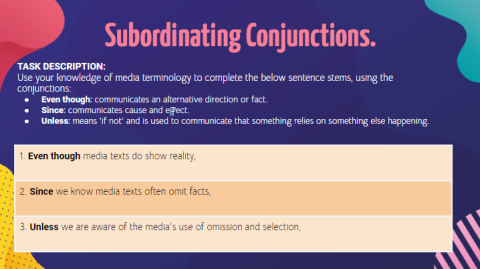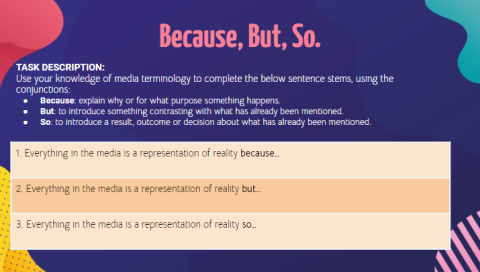Published 24 Apr 2023
Building student capacity through The Writing Revolution - Richmond High School
Engaged students in learning
Seamus Kavanagh – English Teacher / Year 8 Coordinator
Richmond High School
Schools and early childhood services across Victoria continue to provide quality learning experiences across all levels. The VIT’s Professional Practice team is privileged to see this work first hand on visits to workplaces around the State. Here is just one example spotlighting the great work happening in a Victorian school.
Seamus Kavanagh is an English teacher at Richmond High School and was awarded the Outstanding Early Career Secondary Teacher winner at the 2022 Victorian Education Excellence Awards. We spoke to Seamus about how implementing interventions using The Writing Revolution approach can improve students’ writing skills.
Q: Can you give some background to the development of your approach to the initiative, including any research or established models / strategies that your approach is based upon?
Open since 2018, Richmond High School is located on the land of the Wurundjeri Woi Wurrung peoples in Melbourne, Victoria. 2023 is the first year the school has a complete student population of year 7-12 classes. Being a new school, our staff are keenly focussed on implementing pedagogical interventions to help students succeed both inside and outside of school, and the staff culture is one of continuous growth and support.
Following data analysis and interpretation of various standardised tests (NAPLAN and PAT), as well as formative and summative assessments in the classroom, the school leadership identified writing as an area for growth. Head of English Annabel Barton, alongside the English faculty, began to implement interventions aimed at building students’ writing capacity based on the Hochman Methodology, as showcased in The Writing Revolution.
The Writing Revolution (Hochman Methodology) is an educational approach that aims to improve students' writing skills by focusing on the fundamentals of writing – working from sentence level composition to paragraph level. Developed by Judith C. Hochman, this approach is based on the belief that writing is a skill that can be taught and mastered by all students, regardless of their backgrounds or abilities.
By adopting this approach, our school aims to help students become better writers, critical thinkers and communicators, equipping them with the skills they need to succeed post-school. The approach links clearly to multiple high impact teaching strategies (HITS) such as explicit teaching, multiple exposures and worked examples.
Ensuring the teaching of writing is based clearly in the context of classroom learning and curriculum, this approach focuses on strategies aimed at improving students’ use of grammar and syntax.
Q: What structural things are in place to ensure that the initiative has its best chance at success?
Our English team has developed this practice through our Professional Learning Communities (PLCs) and faculty meetings, ensuring that the writing focus permeates throughout our curriculum construction and implementation, as well as facilitating a growing understanding of these strategies in our Humanities faculty. In future, we hope to see the strategies spread across curriculum domains, to help students address the literacy demands of each subject.
In terms of implementation, we have connected the strategies with the E-5 instructional model. The writing strategies have mainly been centred on the evaluate aspect of the lesson model, encouraging students to demonstrate their evolving understanding of a skill or concept through short writing tasks.
RHS Head of English, Annabel Barton, has taken The Writing Revolution and condensed this into our own RHS Handbook to aid staff in embedding this into our curriculum. In this, she has outlined the theory and rationale behind certain interventions and the activities or strategies for enacting these in the classroom.
A key strategy we employed in 2022 was a focus on basic conjunctions through the ‘because, but, so’ strategy. Our English faculty has integrated this strategy into lessons, building students’ abilities to write effective and complex sentences.

'Because, But, So' strategy

'Because, But, So' strategy
Q: What are the greatest benefits to staff development of this approach?
Our shared focus on The Writing Revolution has resulted in multiple beneficial outcomes for staff development.
Firstly, it has improved the collective teacher efficacy through staff collaboration in our faculty meetings and construction of shared goals. By actively learning, practicing and planning these strategies, we have built a shared understanding of the benefit for our students.
Secondly, it has improved our capacity for performing and implementing deliberate practice in the classroom. In this sense, we have followed a step-by-step approach to writing instruction, coupled with explicit teaching and targeted feedback, to ensure students are building their writing in a deliberate manner, rather than providing them with twenty minutes to write and a blank sheet of paper.
Lastly, introducing this approach has bolstered our evidence collection as it has allowed for both formative and summative assessment tools to improve alongside the intervention. The strategies are fantastic diagnostic tools in the classroom and have now been integrated into writing task developmental rubrics.
Here are two examples from Year 10 and Year 7 respectively that highlight how the ‘because, but, so’ strategy can be used to evaluate student learning in a single lesson.
Q: What have been the benefits to learner outcomes of this approach?
The benefits to learner outcomes of The Writing Revolution have been clear in our assessment data and multifaceted in our observational data. The benefits have ranged from improved clarity and coherence, enhanced creativity, greater attention to detail, and improved editing and reviewing skills.
Through strategies focussed on using conjunctions and appositives correctly, students improve the clarity and coherence of their sentence and paragraph level writing. This allows them to convey their ideas to the reader more effectively – a skill that is needed in analytical writing throughout high school and beyond.
An example of this is the use of appositives which demonstrates how this strategy was implemented in a lesson for Year 9 on the film Jojo Rabbit.
Further benefits to learner outcomes are creativity and attention to detail. Through these writing strategies, students are able to experiment with different writing structures, styles and techniques to enhance the analytical or persuasive elements of their pieces. In addition, the focus on word choice, sentence length and syntax allows students to create more sophisticated and nuanced pieces of writing. Lastly, a key strategy in our Writing Revolution is the editing and review of students’ own writing and the writing in worked examples. This builds students’ metacognition and their capacity to identify and correct errors in wiring.
These interventions began in 2021 and following this, our 2022 NAPLAN writing data was markedly improved from previous results. Although only an initial interpretation of the impact of this ongoing intervention, and albeit one that is fraught with the limitations often associated with NAPLAN and other standardised tests as stand-alone data points, it is an encouraging sign. We hope to see this continued in 2023.
Q: What plans does your workplace have to take this approach forward?
Moving forward, there are two desired outcomes for this approach
- continue to build on these skills in the English faculty and start to focus further on paragraph level composition - although there is still a need to continue our focus on sentence level writing, in the future this will extend to lengthier pieces with the same emphasis on clarity, complexity and metacognition
- see this approach move across faculties so literacy and writing are utilised and improved upon across learning areas.
An example of how these strategies could be used in Math classes is
- the square root of 2 is irrational because…
- the square root of 2 is irrational, but…
- the square root of 2 is irrational, so…
Hence, we hope that the ‘revolution’ spreads at Richmond High School and continues to improve our students’ capacity in writing.
Q: Can you detail any references or citations applicable?
- The Writing Revolution - Hochman Methodology, Judith C. Hochman
- High impact teaching strategies (HITS) – Department of Education
Do you have an example of outstanding work in your school or early childhood service? We’d like to consider showcasing it the Excellence in Teaching section of our website. Send your example and contact details to vitcomms@vit.vic.edu.au.
